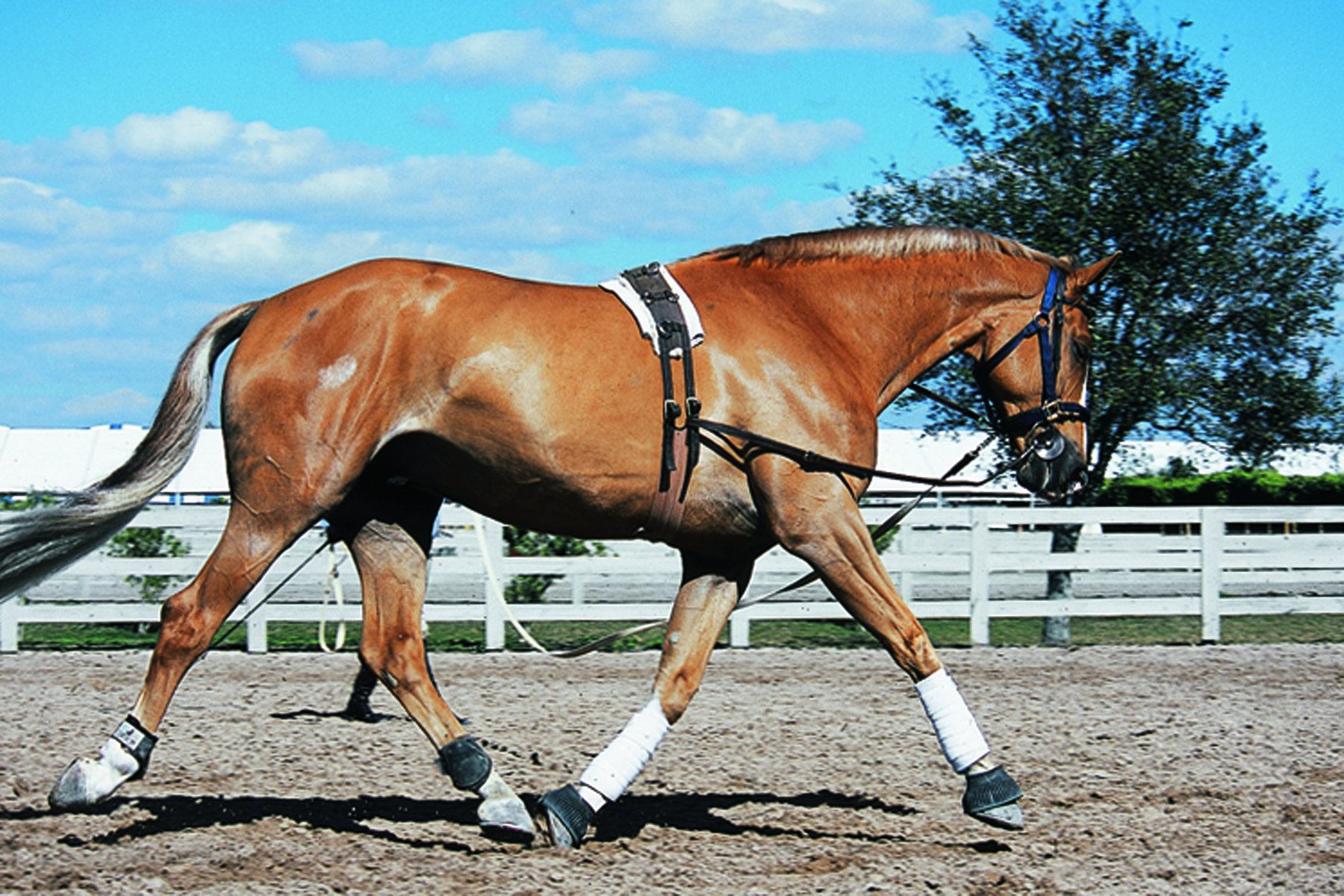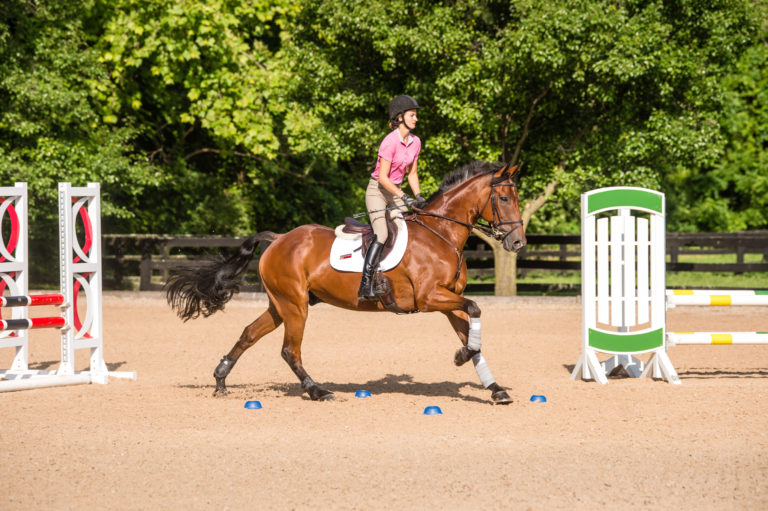I use a simple program to maintain my horses’ soundness (and their sanity) by keeping them fit and helping them stay both strong and loose behind. Jumping is a very small part of the overall program; even our “4-foot” horses rarely jump more than 3 feet except in the ring. The real secret is flatwork, ground poles/small jumps, and longeing.

Flatwork First
I ride each horse on the flat for ten to fifteen minutes of walk/ posting trot/canter, with frequent transitions within and between the gaits, keeping the work quiet but forward and using my leg to send him up into my hand. I want to feel his hind end stepping up underneath so that he’s balancing and carrying himself, not trailing his back legs out behind. Part of the feeling of him coming under from behind is that I can have a “conversation” between the leg and the hand; ultimately I want to reach a point where he comes up and into my hand but not through my hand. When he’s carrying himself well, he’s comfortable and can jump well with the least effort. That’s when we move on to …
Cavalletti and Jumps
I put three cavalletti poles 4 feet apart and incorporate them into a figure eight. I start out by posting the trot over the poles?because if my horse is the careful type who instinctively wants to jump the first pole, my posting speed and rhythm encourage him to continue trotting and place himself correctly to step over instead. I pick up a canter as I circle away from the third pole, then ask for a downward transition to trot as we approach the first pole again. I want to feel him come into the trot with his withers?his whole topline?coming up in front of me as he steps under himself behind (rather than coming down to the trot, tipping forward, and pushing out behind). When he’s comfortable trotting the poles, I alternate posting them, sitting the trot, and riding through in two-point.
As we continue, I’m looking to feel more impulsion, natural carriage, and elasticity. I want my horse not to think it’s some kind of monumental step to go from flatwork to jumping. That’s key. The two things can be done together to establish connection, get him supple and carrying himself, and get him focused on listening to my legs, listening to the transitions. Often I’ll incorporate a little trot X or a bounce into the line of poles, so he trots through them and gets his placement to the fence. Or I ride a figure eight over a small vertical to integrate the idea of keeping his canter at a consistent pace and rhythm while stepping over a jump in the middle.
When my horse is going well, I think of him as being “at my leg”: relaxed but not weak-feeling (behind my leg) or so far in front of me that he’s almost running through the connection and I can hardly put a leg on him. When he’s at my leg, I can almost entirely take my leg off, softly put my hands forward, and not change his balance; he carries himself. He can do this only if I stay consistently in the middle of him; my shoulders may move, depending on the gait and whether we’re jumping, but my seat and hips stay straight over my leg.
Longeing to Encourage Connection
I longe horses not to wear them down (a terrible horse-show practice that I think causes many injuries and shortens many careers), but as a different way to accomplish what I’m working on from their backs. It adds variety to the program and can be an effective alternative for educating a horse with a somewhat stiff or “dead” mouth. I don’t longe daily; for most horses, the schooling session I’m about to describe is a once-a-week or every-second-week thing.
My longe work is 90 percent at the trot—because at that gait, when the work is correct, I get the most pronounced range of motion in a horse’s back end as he steps in and pushes under. The two-beat gait also encourages him to move with a rhythmic “swing.” The payoff: When horses find their correct balance point, they become very comfortable and fun to ride. The balance unlocks their withers, so they can open their shoulders and step up and under behind, carrying themselves in an animated, lively way that’s also polite—they go to, not through, your hand.
My longeing equipment includes: a bridle fitted with a loose-ring hollow snaffle, reins removed; a longeing surcingle with pad; adjustable side reins (I prefer the type with the big rubber donut); a halter; and a longe line with an 18-inch chain. I thread the chain through the middle ring of the halter at the jaw and up over the noseband, snapping it to the halter’s far ring. (This lets me longe in either direction, without changing the chain?and risking let the horse get away from me.)
To begin, I fasten the side reins back to the surcingle and let my horse loosen up at trot for five to eight minutes in each direction. Then I start to work on the objective: encouraging him to bend in and keep his shoulder out (this counteracts the leaning in that a horse does when he gets stiff) by adjusting the inside side rein slightly shorter and fastening it higher on the surcingle than the outside rein. Once he’s established that bend, I want to see his hind end tracking straight or just a few degrees to the inside of the front end, and really engaging and stepping under: being loose and active with a strong, rhythmic range of motion, the hocks working much like pistons. When he’s carrying himself that way—balanced back over his hind end, pushing through and into the inside side rein comfortably—he can slow down and still maintain the elasticity and energy. When he’s done this enough to find his balance and really understand the work, I can relax the side reins and he’ll do everything quite correctly with almost no connection.
This is a slow, steady process. It has nothing to do with jerking or pulling or being fast or rough. If something doesn’t happen fast enough (or what I thought was fast enough), that’s OK. It will happen.
This article originally appeared in the June 2003 issue of Practical Horseman. To read more from Morgan Thomas, see Here’s How in the April 2011 issue.










